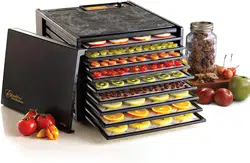Loading ...
Loading ...
Loading ...

17
Excalibur® adjustable thermostat has been specifically designed to create a proper fluctuation
in the air temperature. As the air temperature fluctuates up, it quickly evaporates moisture
from the surface of the food. Then as air temperature fluctuates down, moisture from the
center of the food moves to the dryer outer surface. This proper fluctuation in temperature
also helps to keep the food temperature very constant throughout the entire dehydrating
cycle.
Food Temperature vs. Air Temperature
During the dehydration process the food temperature is generally 20 to 30 degrees F cooler
than the air temperature, due to the effects of evaporation. As the warm air blows across the
food, moisture is evaporated from the foods surface, creating a cooling effect that keeps the
food temperature cooler than the air temperature. Keep in mind that the dial settings represent
air temperature, so the air temperature may be as much as 25 degrees higher.
Enzymes and Temperature
There are many varying opinions among raw foodists concerning the temperature at which
enzymes become deactivated. The most frequently quoted temperature is 118ºF/47ºC / (food
temperature) based upon the studies of Dr. Edward Howell. However, he also states that the
optimal temperatures for enzymes are between 45º/7ºC and 140ºF/60ºC, and temperatures
above 140ºF/60ºC will destroy all enzymes. We have discovered through research and testing,
that the second of these two statements is more accurate when dehydrating, and that enzymes
can actually withstand food temperatures into the 140ºF/60ºC. According to Dr. John Whitaker,
a world recognized enzymologist, and emeritus professor and Dean of the Food Science and
Nutrition department at UC Davis in California; most enzymes do not become deactivated
until they reach between 140ºF/60 ºC and 158ºF/70ºC. This supports Howell’s statement of
140ºF/60ºC, as well as our tests and scientific experiments. We have tested food samples
for enzymatic activity that were dried at temperatures up to 145ºF/63ºC and found it to be the
same as in the foods dried at lower temperatures.
Enzymes are also most susceptible to damage by high heat while the food is wet. Once a
high percentage of the foods moisture has been removed, the enzymes become more stable
or dormant, and can withstand food temperatures higher than 155ºF/68ºC, according to
Viktoras Kulvinskas. When the food is rehydrated with water or in the digestive track the
enzymes become active again and assist your body’s enzymes in the digestive process.
How to use your Dehydrator for Living Foods
According to Ann Wigmore and Viktoras Kulvinskas, the best way to preserve the living
enzymes, and overcome the potential of spoilage or bacteria growth, is to set the dehydrator
on the highest temperature setting for the first two or three hours, then turn it down to less
than 120ºF/49ºC for the remaining time. During the initial hours the food temperature will not
exceed 118ºF/47ºC because of the high moisture content in the food. Neither will the air
temperature immediately rise to 145ºF/63 ºC. It may take several hours to get up that high.
Following this procedure will cut the lengthy (30+ hours) drying time in half. If you cannot be
there to turn the dehydrator down you may set at a lower temperature between 105ºF/41ºC
and 120ºF/49ºC, but keep in mind that the lower the setting, the longer it will take to dehydrate.
Loading ...
Loading ...
Loading ...
